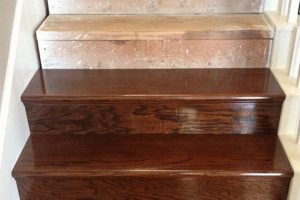The concluding stages of a weaving project on a frame-based device involve securing the woven material and removing it from the apparatus. This process typically necessitates a specific set of techniques to prevent unraveling and ensure the integrity of the completed textile. For example, carefully knotting the warp threads together or employing a fringe-twisting method are common approaches.
Proper completion of a woven piece is crucial for preserving the time and effort invested in its creation. It guarantees the longevity and usability of the resulting fabric. Historically, meticulous edge finishing has signified a high level of craftsmanship and attention to detail, contributing to the overall value and appreciation of the woven product.
The following sections will detail various methods for finalizing a weaving project, providing practical guidance on techniques such as securing warp threads, creating different types of fringes, and addressing common challenges encountered during the dismounting and finishing process.
Essential Strategies for Weaving Project Completion
Effective strategies are crucial to ensuring a professional outcome in weaving projects. Adhering to the following guidelines will help to finalize woven pieces with skill and precision.
Tip 1: Secure Warp Ends Meticulously: Before removing the weaving from the frame, securely knot the warp threads in small groups. This prevents unraveling and maintains the fabric’s integrity. For added security, a weaver’s knot is recommended.
Tip 2: Maintain Even Tension: When tying off the warp threads, ensure consistent tension across the entire width of the fabric. Uneven tension can distort the final shape and appearance of the weaving.
Tip 3: Consider Fringe Options: Experiment with different fringe styles, such as twisted fringes, braided fringes, or simple knotted fringes. The chosen style should complement the overall design and intended use of the woven piece.
Tip 4: Utilize a Finishing Needle: A tapestry needle or similar blunt-tipped needle can be useful for weaving in loose ends or securing edges. This provides a clean and professional finish, hiding any stray threads.
Tip 5: Blocking for Shape: After removing the weaving from the frame, consider blocking it to ensure a uniform shape. Lightly dampen the fabric and pin it to a padded surface in the desired dimensions. Allow it to dry completely.
Tip 6: Explore Edge Finishing Techniques: Techniques like hemstitching or adding a woven heading can create a polished and durable edge. This is particularly important for items that will experience wear and tear.
Tip 7: Inspect for Imperfections: Thoroughly examine the finished weaving for any imperfections, such as loose threads or missed knots. Address any issues before presenting or using the piece.
By employing these techniques, a weaver can guarantee the structural integrity and aesthetic appeal of the finished piece. The successful completion of a woven work is a testament to the weaver’s skill and dedication to their craft.
In conclusion, mastering the techniques discussed ensures a professional outcome, maximizing the longevity and visual appeal of each creation. Careful attention to these details elevates the quality and impact of any weaving project.
1. Secure warp ends
Securing warp ends represents a fundamental and indispensable stage in the completion of any weaving project. Its execution directly determines the structural integrity and aesthetic lifespan of the finished textile, making it a critical component of the overarching process.
- Knotting Techniques and Their Variations
The process of securing warp ends often involves a variety of knotting techniques, each offering varying degrees of security and visual appeal. Overhand knots, square knots, and weaver’s knots are commonly employed. The specific choice depends on the yarn type, the desired fringe style, and the anticipated wear and tear of the woven item. Improper knotting leads to unraveling and a diminished lifespan of the piece.
- Tension Management During Knotting
Maintaining consistent tension across all warp threads during the knotting process is essential to prevent distortion and unevenness in the finished fabric. Variations in tension can cause puckering, warping, or an irregular fringe line. Careful attention to this detail ensures a professional appearance and structural stability.
- Integration with Fringe Design
The method of securing warp ends directly influences the design and appearance of the fringe. Leaving the ends loose allows for a simple, flowing fringe, while twisting or braiding the ends creates a more elaborate and decorative effect. The securing method must be considered in relation to the intended aesthetic of the final product.
- Use of Finishing Tools
Specialized tools, such as tapestry needles or crochet hooks, can assist in securing warp ends and weaving in loose threads. These tools provide greater precision and control, particularly when working with delicate or densely woven fabrics. Their use contributes to a cleaner and more professional finish.
In summary, “Secure warp ends” isn’t merely a final step but an integral design consideration that interacts significantly with the final aesthetic and usability of the weaving. Each choice made during this securing process reflects the weaver’s skill and attention to detail, ultimately contributing to the creation of a lasting and visually appealing piece.
2. Even tension maintenance
Maintaining uniform tension during weaving is intrinsically linked to the final steps of securing the weave on a loom. Uneven tension accumulates stress points within the fabric structure. This stress becomes significantly problematic during the finishing process, often manifesting as distortions or puckering once the woven piece is released from the loom’s frame. A practical example is a weaving intended as a square, where inconsistent tension during its creation will inevitably lead to a parallelogram or other irregular shape upon removal. Therefore, even tension maintenance is not merely a technique during weaving, but a crucial precursor to a successful completion.
The impact of consistent tension extends beyond the overall shape of the fabric. It also affects the integrity of the edge finishing. Securing warp threads, whether through knotting, hemming, or other methods, becomes significantly more challenging if the tension is erratic. Warp threads pulled too tightly will resist even distribution during knotting, creating an uneven fringe or hemline. Conversely, loose warp threads are prone to slipping or unraveling, compromising the security of the finished edge. A common occurrence is the creation of a rug. If tensions are ignored there is less likelihood that you will be able to create a professional-looking rug.
In conclusion, even tension maintenance is a non-negotiable component of achieving a structurally sound and aesthetically pleasing finish for any weaving project. Neglecting this aspect introduces complications that directly impact the final appearance, potentially necessitating corrective measures or resulting in an unsatisfactory outcome. Mastery of tension control during the weaving process translates directly into a smoother, more predictable, and ultimately more successful completion.
3. Fringe style selection
The decision regarding fringe style directly dictates several procedural steps when concluding a weaving project. The chosen style influences the manner in which warp ends are secured, the tools required, and the time investment necessary for completion. For example, a simple knotted fringe necessitates a different approach compared to a complex braided or macram-inspired design. A decision to incorporate beads or other embellishments further alters the finishing process, requiring specific attachment techniques and potentially affecting the durability of the fringe.
The relationship between fringe style and overall structural integrity is also notable. Certain styles, such as tightly twisted fringes, offer greater resistance to unraveling and wear compared to loosely knotted alternatives. This consideration is particularly relevant for functional woven items, such as scarves or shawls, where the fringe is subject to frequent friction and handling. A poorly chosen fringe style can compromise the lifespan of the woven piece, rendering it aesthetically pleasing but structurally unsound. In the realm of rug weaving, the selection of a durable fringe style, often involving reinforced knots or additional securing methods, becomes paramount to prevent fraying and maintain the rug’s integrity over time.
In summary, fringe style selection is not a purely aesthetic choice, but rather an integral component of the weaving process. It has significant practical implications for the securing of warp ends, the structural integrity of the finished piece, and the overall durability of the fringe. Careful consideration of these factors ensures a harmonious and lasting result, where the fringe both enhances the visual appeal and contributes to the longevity of the woven item.
4. Edge finishing options
The selection of appropriate edge finishing techniques represents a crucial stage in completing a weaving project. These options directly impact the durability, aesthetic appeal, and overall usability of the finished woven item. Careful consideration of available techniques is essential for optimizing the outcome.
- Hemstitching and Its Structural Implications
Hemstitching involves securing the warp threads to create a clean, defined edge. It offers a simple yet effective method for preventing unraveling and adding structural support to the fabric’s perimeter. This technique is particularly suitable for lightweight fabrics and items requiring a subtle, understated finish. It is a fundamental element to how to finish a weave loom.
- Adding a Woven Heading for Enhanced Durability
A woven heading involves creating a short section of plain weave at the beginning and end of the project. This strengthens the edges and provides a stable foundation for further finishing techniques. This method is commonly employed in rug making and other applications where durability is paramount. Creating a woven heading is an effective strategy on how to finish a weave loom.
- Selvedge Reinforcement Techniques
Selvedge reinforcement involves incorporating additional warp threads or employing specialized weaving patterns to strengthen the edges of the fabric. This technique is particularly useful for preventing fraying and maintaining the integrity of the selvedges, especially in fabrics subjected to frequent handling or stress. These steps on selvedge reinforcement are an important part on how to finish a weave loom.
- Fringe as an Edge Finishing Element
A fringe, whether knotted, twisted, or braided, serves not only as a decorative element but also as a functional edge finishing technique. Properly executed, a fringe can prevent unraveling and add visual interest to the woven piece. The selection of an appropriate fringe style should be considered in relation to the overall design and intended use of the textile. Fringe style is the final touch of how to finish a weave loom.
The choice of edge finishing options should align with the specific requirements of the weaving project, considering factors such as fabric weight, intended use, and desired aesthetic. Mastery of these techniques enables the creation of durable, visually appealing, and professionally finished woven items.
5. Blocking for shape
Blocking, a crucial post-weaving process, directly influences the final dimensions and structural integrity of a woven textile. The need for blocking often stems from inherent tension variations introduced during the weaving process itself. These variations, even when minimized by skilled practitioners, can manifest as distortions or irregularities in the fabric’s shape upon removal from the frame. Therefore, blocking becomes an essential rectification step to achieve the intended geometrical form, particularly for items like scarves, blankets, or tapestries where precise dimensions are required. The practice directly affects the end result regarding how to finish a weave loom.
Consider a handwoven rug. The weaving process, despite best efforts, may result in slight tapering or uneven edges. Blocking, in this scenario, allows the weaver to stretch and manipulate the fabric while damp, pinning it to a flat surface to dry in the desired shape. This process ensures that the rug lies flat on the floor and maintains its rectangular form over time. Without proper blocking, the rug might buckle, warp, or exhibit persistent irregularities, thereby detracting from both its aesthetic appeal and functional utility. Another pertinent example is a tapestry. Blocking aids in aligning the individual design elements within the woven structure, enhancing the visual clarity and impact of the artwork. This is relevant to how to finish a weave loom.
In conclusion, blocking is not merely a cosmetic finishing touch; it is an integral component of how to finish a weave loom, serving to correct distortions, stabilize the fabric structure, and ensure that the final product conforms to the intended specifications. While weaving skill minimizes the need for extensive blocking, understanding and properly executing this process is crucial for achieving professional-quality results and ensuring the longevity and usability of the woven piece. Without it, time invested may not have created a well-balanced piece.
Frequently Asked Questions
The following questions address common points of inquiry regarding the final stages of a weaving project, specifically the processes undertaken after the fabric has been created on a loom.
Question 1: What constitutes the most critical step in completing a weaving project?
Securing the warp ends effectively represents the most vital step. Failure to adequately secure these threads will inevitably lead to unraveling, compromising the structural integrity and longevity of the woven piece.
Question 2: How does tension during weaving impact the finishing process?
Uneven tension during weaving introduces stress points within the fabric, complicating the finishing process. Distortions, puckering, or irregular shapes may manifest upon removal from the loom, necessitating corrective measures such as blocking.
Question 3: Is fringe purely a decorative element?
While fringe undoubtedly contributes to the aesthetic appeal of a weaving, it also serves a functional purpose. A well-chosen fringe style can reinforce the edge of the fabric, preventing unraveling and enhancing its durability.
Question 4: What are the advantages of hemstitching as an edge finishing technique?
Hemstitching provides a clean, defined edge, prevents unraveling, and adds structural support. It is particularly suitable for lightweight fabrics and projects requiring a subtle, understated finish.
Question 5: When is blocking a necessary step in the finishing process?
Blocking is typically necessary when the woven fabric exhibits distortions or irregularities in shape. It allows the weaver to manipulate the damp fabric into the desired dimensions, ensuring a uniform and professional appearance.
Question 6: Can specialized tools improve the quality of the finishing process?
Yes, tools such as tapestry needles, crochet hooks, or specialized knotting tools can significantly enhance the precision and efficiency of the finishing process, particularly when working with delicate or intricate designs.
In summary, proper completion involves a multi-faceted approach, considering structural stability, aesthetic considerations, and appropriate techniques for securing, shaping, and finishing the woven fabric.
The subsequent section will explore specific techniques for troubleshooting common challenges encountered during the finishing process.
Concluding Considerations
The preceding sections have explored the critical aspects of concluding a weaving project. Securing warp ends, maintaining even tension, selecting appropriate fringe styles, employing suitable edge finishing options, and utilizing blocking techniques collectively determine the final quality and longevity of the woven piece. Each stage demands careful attention to detail and a thorough understanding of its impact on the overall result.
Mastery of these processes ensures that a weaving project achieves its full potential. Continued exploration and refinement of finishing techniques will elevate the craftsmanship of woven textiles, contributing to the preservation and advancement of this enduring art form. Further research and practice are encouraged to enhance skills in how to finish a weave loom.







